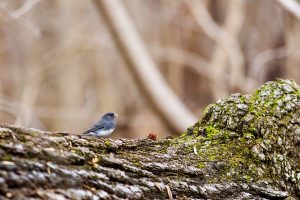Junco Politics

I came upon my first dark-eyed juncos on an early Spring afternoon in 2012, new binoculars and a tiny book of Minnesota birds in my back pocket. A small flock had sheltered within a patch of evergreen bushes, one of only four species I saw that day. It’s not a particularly noteworthy bird, with no golden orange or bright blue feathers, no strange plumages; it’s just a small, dark gray bird with a white belly, its song a quiet metallic trill.
But I was hooked, excited not just from seeing a junco for the first time, but from learning of its very existence. They’re common, normal, and here every year, they even scavenge beneath birdfeeders, and yet I was unaware of them until that day. Beyond obvious differences in size or color, different species seemed frustratingly similar during that first year of birding: all were bird-shaped, flew in the sky, sounded like a bird. Identifying common species—yellow-rumped warbler, barn swallows, spotted sandpipers—only came after painstakingly thumbing through my new Sibley’s field guide.
When I found myself in the Cascade Mountains that August, then, I couldn’t quickly connect the birds there and those back home in Minnesota. I happened across several little non-descript individuals one afternoon, streaked brown bodies with solid, dull black heads, as though dipped in coal ash. After the requisite thumbing through my field guide, I had an unexpected ID: more dark-eyed juncos.
There are, it turns out, several subspecies, five of which look quite different from each other, so much so that they had been considered separate species by the American Birding Association until 1973. The juncos in Minnesota were “slate-colored” juncos; these new ones were “Oregon” juncos. A couple of weeks later, on the drive back through the Rocky Mountains, I found a cluster of the “pink-sided” subspecies fighting with each other along the edge of a campground.
The multiracial world of juncos raised all manner of questions. Why all those subspecies? Why isn’t there more interbreeding? How do the slate-colored juncos survive the Minnesota winter? Where do they go in the summer? These are all answerable, at least to some degree, but the answers just beg more difficult questions, like where exactly the difference lies between a species and a subspecies (hint: there isn’t one answer), or why some junco subspecies are confined to a small region while others spread across the continent.
* * *
My political baptism began at the end of that same Spring, as Minnesota emerged from hibernation, schools let out, and trees were finally in full leaf. Local activists asked me to run for the state House of Representatives with the DFL party—what we call the Democratic party in Minnesota, merged with the earlier Farmer and Labor parties. In retrospect I was clearly a last-minute candidate, approached in the final weeks to avoid gifting an uncontested election to the other side.
I did run, and I lost. I also unexpectedly found a little window into how becoming a public, political candidate can shape what I think I know, and in ways perhaps only more relevant a decade later. As the months and then weeks counted down to election day, the campaign became a pervasive feedback loop of saying and writing opinions, being affirmed or challenged by others, then saying the opinions again, resulting in my prior beliefs only being reinforced. Psychologists have long studied tendencies like this. Philip Tetlock, for instance, discussing the earlier work of Leon Festinger in a recent interview, noted that “people who make public commitments to a position are going to . . . become better and better at generating reasons why they’re right and their would-be critics are wrong.”
Let’s take my debates as an example. Debates for local office are like their better-known presidential cousins, just with audiences quite small. The breadth of issues covered could be quite wide, however. Candidates were asked about taxes and tax cuts, healthcare policy, job creation strategies, same-sex marriage (a ban was on the ballot in Minnesota), requiring voter IDs (also on the ballot), bipartisanship, school funding, funding for public colleges and universities, conservation policy, highways and bridges, the local half-built commuter rail, and union support.
It is simply impossible to be an expert in all of that. I researched what I could between my job and my kids, but I often had to rely on fact sheets and talking points provided by the DFL, knowing it wasn’t at all the same thing as having built a hard, defendable argument after years of study on a complicated subject.
Thus began what I felt most uncomfortable with: saying things I felt reasonably confident in, yet I knew I could in no way defend in front of actual experts. It isn’t lying, precisely, but it didn’t feel responsible. I didn’t always know what I was talking about, and neither did anyone else up on stage with me.
The epistemological problem goes deeper, though. I also slowly began to talk and think about complex policy issues as though I in fact did have authority and knowledge. After repeating something over and over, I came to believe it as truth, and especially after repeating it in public. Under-informed statements solidified into assumptions and moral convictions. I found myself dumber from the process. Politicians (as they are humans) often don’t know what they’re talking about, and all politicians (still being humans) are ignorant about most things. I had forgotten my own ignorance.
* * *
I was lucky, in a personal sense, in that I lost. The feedback loop was cut off and I was no longer expected to pronounce solutions for multiple large-scale policy issues. There’s no end date with Twitter or Facebook, though, no endpoint provided by election day. It’s possible to stay on our proverbial soap boxes, however just and justifiable; I wonder how quickly we all come to believe we understand the nuances of things beyond us, how much we have all been made into amateur politicians.
I was also lucky to find the birds. Campaigns come with hard deadlines and a felt need to provide answers when asked. But birds let you take as long as you like, at least until they fly off—and even then you can write down what you saw and come back to it later. Part of the process of birding, especially for the first few seasons, is learning to be okay with not knowing what it was that just flew by, knowing that you’ll never know what that flash of color was.
This seems all the more important today, ten years later, an age of misinformation and polarization and omnipresent screens. A world outside of the political chaos exists, a literal, physical, world of infinite complexity and mystery and beauty and tragedy. And while our politics affect that world, too often disastrously so, walking slowly and simply listening—to the birds and (increasingly) the absence of birds—taught me about my own smallness, that for every tiny answer I might think I learn, many more new questions follow.
#
Richard Bohannon is a cartographer and sociologist of religion, and Assistant Professor of Individualized and Interdisciplinary Studies at Metropolitan State University in St. Paul, MN. His current research and work focus on the narrative role of maps, religious and otherwise.
Counterpoint blogs may be reprinted with the following acknowledgement: “This article was published by Counterpoint Navigating Knowledge on 16 February 2022.”
The views and opinions expressed on this website, in its publications, and in comments made in response to the site and publications are those of the author(s) and do not necessarily reflect the views and opinions of Counterpoint: Navigating Knowledge, its founders, its staff, or any agent or institution affiliated with it, nor those of the institution(s) with which the author is affiliated. Counterpoint exists to promote vigorous debate within and across knowledge systems and therefore publishes a wide variety of views and opinions in the interests of open conversation and dialogue.
Photo credits: “Dark-eyed junco” © Melissa McMasters 2022, free download from Flickr.



